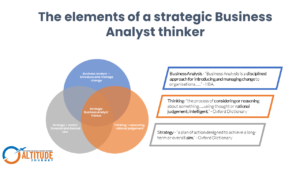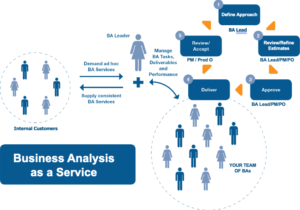Why Good Business Analysis Involves More Than Gathering and Managing Requirements
While the basic function of a Business Analyst (BA) may be broadly understood as gathering, developing and managing business requirements, so many more activities contribute to effective and authentic business analysis practice.
Good business analysis ultimately results in wide-scale improvements and value creation as well as a deeper and clearer understanding of technology and its purpose across an entire organization.
Outside of requirements management, here are just a few of the important elements of effective business analysis.
- Budgeting, financial forecasting, modelling and reporting
Generally, BAs are engaged with a project after the project is approved with defined budget and timelines. However, this practice can produce many challenges and limited project success. Challenges include not fit-for-purpose solutions, scope creep, budget variations, limited usage of existing enterprise platforms, multiplying applications of similar functionality … and an end result of insignificant business value.
To address this, BAs at VU conduct a minor but critical analysis prior to projects commencing in order to approve and assign budget to the project. We call this a short mandatory analysis to check the viability of the project, focus on identifying the value of the project and aligning it with VU’s IGNITE framework Value Identification Phase.
Running for 3-4 weeks, this process is led by BAs to understand the business problems and various solution options (internal/external) with a priority of assessing internal enterprise platforms first. The short analysis consists of:
- Understanding the business problems through user journey maps.
- Building a blueprint of high-level AS IS process.
- Identifying gaps in AS IS process.
- Building blueprint of TO BE process.
- Identifying Minimal Viable Product (MVP) deliverable within a few sprints.
- Devising context solution overview that shows the overall system with user interaction and dependency on other systems (this identifies the impact on existing systems and their integration points, and the impact on other business areas).
- Providing solution options keeping future in mind.
The outcome of the analysis is shared with vendors for quotation. The MVP option becomes vital in establishing realistic budget and timelines for the project. Post analysis, BA inputs become critical to submission of New Initiative Funds Request (NIFR) to justify the existence of a project through its value and benefits.
A pilot of the short analysis was conducted in 2021 with VU’s introduction of a new Academic Integrity Register. The Academic Integrity Register is an online system developed to record, report and support academic decision-making in relation to academic integrity concerns and breaches of students studying in the higher education and vocational education sector.
- Identifying stakeholders and managing expectations
Identifying relevant stakeholders at the commencement of the project is as important as assigning stable budget to the project. At VU, BAs identify stakeholders and map them through a tool known as a Stakeholder Power Interest Map. The mapping is conducted collaboratively by the business team, communications team and the BA. This helps stakeholders visualize the importance and relevance of the project. Stakeholders can vary from business sponsors to business owners and end users to operational support teams. Mapping demonstrates the stakeholder’s power and interest in the project which tells us how we have to manage their involvement and expectations.
To return to our Academic Integrity Register Project as an example, there were business owners, business sponsors, and roughly 2000 academics as end users of the system. At the commencement of a project, BAs should work closely with business owners to develop a communication plan which includes who needs to be involved at which stage of the project. For example, with our Academic Integrity Register project, business teams led by business owners were involved at all design related workshops and system testing phases. However, it was not possible to involve thousands of end users in User Acceptance testing (UAT), so we asked for senior representatives from each stakeholder group to participate and ensure transition to the new system was successful. These senior representatives became champions of VU’s Academic Integrity Register digital transformation.
Another critical aspect of stakeholder engagement is formulating a Project Control Board. The project owner (business sponsor) assembles a Project Control Board (PCB) and its members to assist in oversight and decision making needed to drive delivery of the project outcomes. BAs identify risks and issues and provide recommendations on approach which are presented at PCB for approval. The PCB also helps in maintaining buy-in and interest of senior leadership.
Advertisement
- Seeking opportunities for greater value creation/realization beyond the immediate solutions required
A system implementation is successful only when the system is used and exploited by end users to a level that value is generated, and business benefits are realized during a defined period of time. For a system to continuously generate value, it has to be designed with future needs in mind. In all projects, though we focus on resolving immediate business needs through delivering MVPs, the entire system architecture should be designed based on future needs and solution expansions.
It goes without saying that implementing a system, deploying it to end users, and asking them to use it without bringing them on a project journey is a big risk to value generation. That’s why it’s essential to ensure representation of each user group at all stages of the project. Taking users along the journey with you keeps them invested and interested. This practice becomes a critical part of value realization. Users must not only accept the system but use it to a level that more opportunities are identified to improve the system, processes and solution itself.
A successful project with high acceptance from end users automatically opens doors for further opportunities in terms of engagement with other strategic prospects, process improvement, building branding through enhancing reputations. For instance, our Academic Integrity Register project enabled many across the business to learn more about CRM products which helped in product selection for other business areas. Project teams, including BAs, became recognized for their expertise and engaged in other strategic initiatives where learnings from this project could be applied.
- Building beneficial relationships – not only with stakeholders but with developers, architects and partners
BAs lead the analysis of business needs, articulate the needs, perform market analysis and internal platform analysis, Request for Information (RFI), Request for proposals (RFP), product selection and vendor on-boarding. Though the BA leads these initial activities, they require Subject Matter Experts (SMEs) from other areas to ensure all the ends meet. For example, BAs collaborate with architects for establishing architecture vision and solution design, and with cybersecurity teams to ensure cyber risk assessment is conducted prior to vendor and product selection. If a decision is made to leverage a third-party provider for implementation to achieve cost saving or shift special functions to more experienced providers, BAs collaborate with partners to ensure the product is built per the business requirements and is fit for purpose. Partnering with external providers comes with its own risks and BAs have to manage these risks and ensure the project continues to be managed effectively.
Historically third-party partners have worked in a more siloed way, creating systems based simply on what was presented to them in the business’ technical specifications document. However, today there is a set of expectations on partners and their developers to add further value to the system implementation and its processes by providing their expert views and leveraging past experiences. This requires a great deal of collaboration, trust and strong partnership between BAs and implementation partners.
Our Academic Integrity Register solution was developed by a third-party partner. Over the duration of the project, a great relationship was built between BAs and the third-party partner. Post success of the project, the third party became VU’s strategic partner in managing the services through a managed service agreement. Win-win.
In summary, experienced and effective Business Analysts observe the pattern of business operations. Findings through these patterns become essential in driving solution recommendation, direction in investments, and alignment in the strategic roadmap.






